Effect of Ni Concentration on the Surface Morphology and Corrosion Behavior of Zn-Ni Alloy Coatings
Abstract
1. Introduction
2. Experimental
3. Results and Discussion
3.1. Effect of Ni Concentration on Coating Thickness
3.2. Surface Morphology and Composition of the Coatings
3.3. Dissolution Behavior of Zn-Ni Coatings
3.4. Salt Spray Tests—Post Exposure Surface Features
4. Conclusions
Author Contributions
Funding
Institutional Review Board Statement
Informed Consent Statement
Data Availability Statement
Acknowledgments
Conflicts of Interest
References
- Conde, A.; Arenas, M.A.; De Damborenea, J.J. Electrodeposition of Zn-Ni alloy coatings as Cd replacement for corrosion protection of high strength steel. Corr. Sci. 2011, 53, 1489–1497. [Google Scholar] [CrossRef]
- Durodola, B.M.; Olugbuyiro, J.A.O.; Moshood, S.A.; Fayomi, O.S.; Popoola, A.P.I. Study of influence of zinc plated mild steel deterioration in seawater environment. Int. J. Electrochem. Sci. 2011, 6, 5605–5616. [Google Scholar]
- Wilcox, G.; Gabe, D. Electrodeposited zinc alloy coatings. Corros. Sci. 1993, 35, 1251–1258. [Google Scholar] [CrossRef]
- Tafreshi, M.; Allahkaram, S.R.; Farhangi, H. Comparative study on structure, corrosion properties and tribological behavior of Zn and Zn-Ni alloy coatings. Mater. Chem. Phys. 2016, 183, 263–272. [Google Scholar] [CrossRef]
- Fei, J.-Y.; Liang, G.-Z.; Xin, W.-L.; Wang, W.-K. Surface Modification with Zinc and Zn-Ni Alloy Compositionally Modulated Multilayer Coatings. J. Iron Steel Res. Int. 2006, 13, 61–67. [Google Scholar] [CrossRef]
- Ghaziof, S.; Gao, W. Electrodeposition of single gamma phased Zn–Ni alloy coatings from additive-free acidic bath. Appl. Surf. Sci. 2014, 311, 635–642. [Google Scholar] [CrossRef]
- Fratesi, R.; Roventi, G. Corrosion resistance of Zn-Ni alloy coatings in industrial production. Surf. Coat. Technol. 1996, 82, 158–164. [Google Scholar] [CrossRef]
- Rahman, M.J.; Sen, S.R.; Moniruzzaman, M.; Shorowordi, K.M. Morphology and properties of electrodeposited Zn-Ni alloy coatings on mild steel. J. Mech. Eng. 1970, 40, 9–14. [Google Scholar] [CrossRef]
- Tozar, A.; Karahan, I. Structural and corrosion protection properties of electrochemically deposited nano-sized Zn–Ni alloy coatings. Appl. Surf. Sci. 2014, 318, 15–23. [Google Scholar] [CrossRef]
- Fashu, S.; Khan, R. Recent work on electrochemical deposition of Zn-Ni (-X) alloys for corrosion protection of steel. Anti-Corrosion Methods Mater. 2019, 66, 45–60. [Google Scholar] [CrossRef]
- Kwon, M.; Jo, D.-H.; Cho, S.H.; Kim, H.T.; Park, J.-T. Characterization of the influence of Ni content on the corrosion resistance of electrodeposited Zn–Ni alloy coatings. Surf. Coat. Technol. 2016, 288, 163–170. [Google Scholar] [CrossRef]
- Abou-Krisha, M.M.; Assaf, F.H.; Toghan, A.A. Electrodeposition of Zn-Ni alloys from sulphate bath. J. Solid State Electrochem. 2007, 11, 244–252. [Google Scholar] [CrossRef]
- Khan, R.; Mehmood, M.; Rizwan, R.; Ahmad, J.; Ul Hasan, M.; Iqbal, Z.; Mudassar, T.; Aslam, M. Corrosion behavior of zinc-nickel alloy coatings electrodeposited in additive free chloride baths. Corr. Eng. Sci. Technol. 2011, 46, 755–761. [Google Scholar] [CrossRef]
- Tuaweri, T.J.; Gumus, R. Zn-Ni Electrodeposition for enhanced corrosion performance. Int. J. Mater. Sci. Appl. 2013, 2, 221–227. [Google Scholar] [CrossRef][Green Version]
- Abd El-Lateef, H.M.; Abdel-Rahman, E.S.; Mohran, H.S. Role of Ni content in improvement of corrosion resistance of Zn-Ni alloy in 3.5% NaCl solution, Part I: Polarization and impedance studies. Trans. Nonferr. Metals Soc. China 2015, 25, 2807–2816. [Google Scholar] [CrossRef]
- Baldwin, K.; Robinson, M.; Smith, C. The corrosion resistance of electrodeposited zinc-nickel alloy coatings. Corros. Sci. 1993, 35, 1267–1272. [Google Scholar] [CrossRef]
- Eliaz, N.; Venkatakrishna, K.; Hegde, A.C. Electroplating and characterization of Zn-Ni, Zn-Co, and Zn-Ni-Co alloys. Surf. Coat. Technol. 2010, 205, 1969–1978. [Google Scholar] [CrossRef]
- Canning, W. The Canning Handbook: Surface Finishing Technology; CBS HB: Delhi, India, 2000; p. 231. [Google Scholar]
- Cramer, S.D.; Covino, B.S., Jr. Corrosion: Fundamental, Testing and Protection; ASM International: Russell Township, OH, USA, 2003; p. 541. [Google Scholar]
- Rahsepar, M.; Bahrololoom, M. Corrosion study of Ni/Zn compositionally modulated multilayer coatings using electrochemical impedance spectroscopy. Corros. Sci. 2009, 51, 2537–2543. [Google Scholar] [CrossRef]
- Rashmi, S.; Elias, L.; Hegde, A.C. Multilayered Zn-Ni alloy coatings for better corrosion protection of mild steel. Eng. Sci. Technol. Int. J. 2017, 20, 1227–1232. [Google Scholar] [CrossRef]
- Crasta, R.J.; Shetty, S. Comparative Study of Electrodeposited Zn and Zn–Ni Alloy Coatings for Improved Corrosion Protection in Chloride Medium. Prot. Met. Phys. Chem. Surf. 2021, 57, 139–146. [Google Scholar] [CrossRef]
- Farooq, A.; Chaudry, U.; Saleem, A.; Deen, K.; Hamad, K.; Ahmad, R. Sacrificial Dissolution of Zinc Electroplated and Cold Galvanized Coated Steel in Saline and Soil Environments: A Comparison. Materials 2021, 14, 744. [Google Scholar] [CrossRef] [PubMed]
- Kelly, R.G.; Scully, J.R.; Shoesmith, D.; Buchheit, R.G. Electrochemical Techniques in Corrosion Science and Engineering; Marcel Dekker, Inc.: New York, NY, USA, 2002; pp. 84–90. [Google Scholar]
- Deen, K.; Afzal, N.; Ahmad, R.; Niazi, Z.; Ayub, R.; Farooq, A.; Khan, I.; Khaleeq-Ur-Rahman, M. Intergranular pitting tendency of yttrium implanted Inconel 600 in acidic chloride media. Surf. Coat. Technol. 2012, 212, 61–66. [Google Scholar] [CrossRef]
- Farooq, A.; Hamza, M.; Ahmed, Q.; Deen, K.M. Evaluating the performance of zinc and aluminum sacrificial anodes in artificial seawater. Electrochim. Acta 2019, 314, 135–141. [Google Scholar] [CrossRef]
- Anwar, S.; Zhang, Y.; Khan, F. Electrochemical behavior and analysis of Zn and Zn-Ni alloy anti-corrosive deposited from citrate baths. RSC Adv. 2018, 8, 28869. [Google Scholar] [CrossRef]

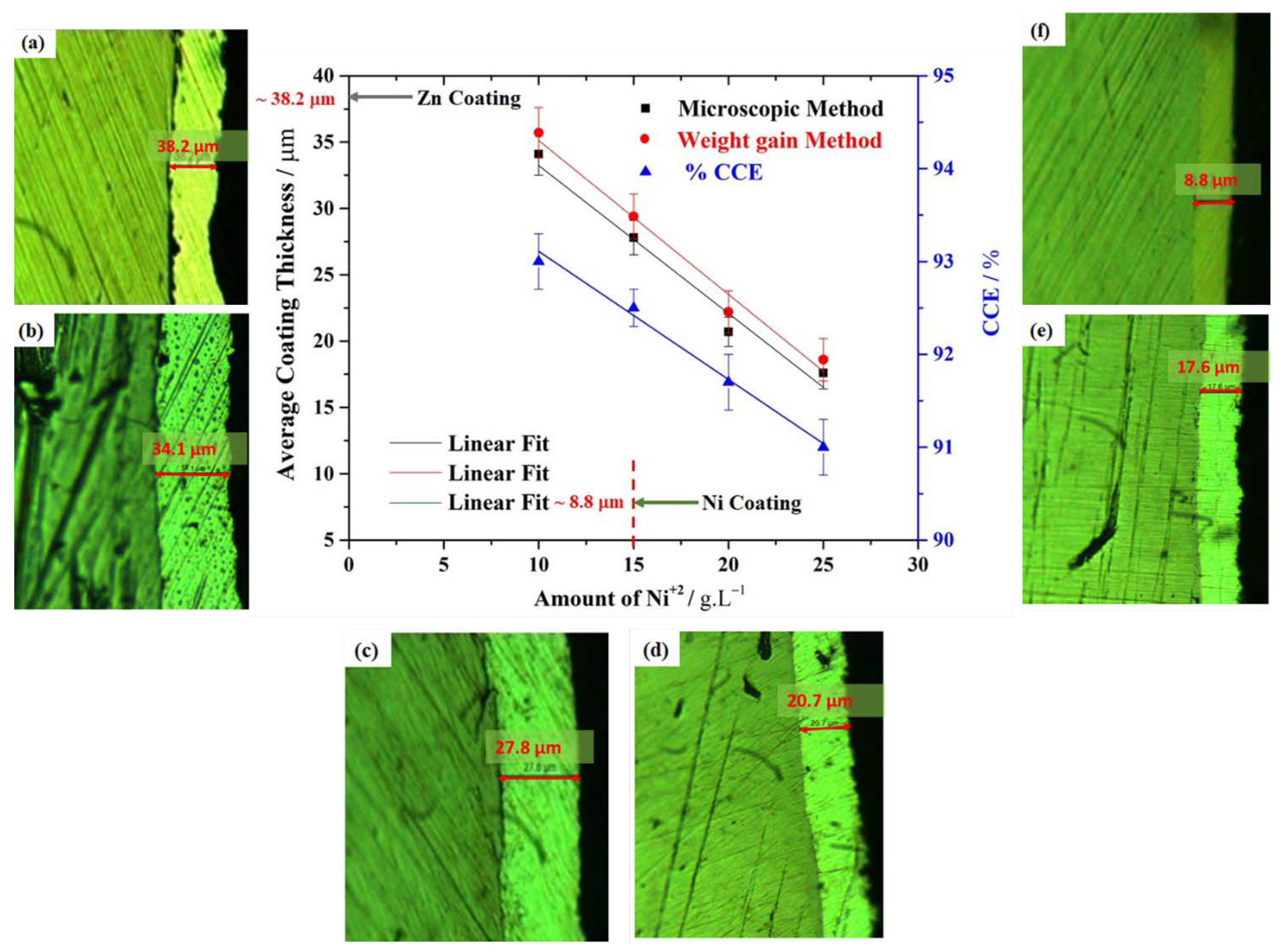
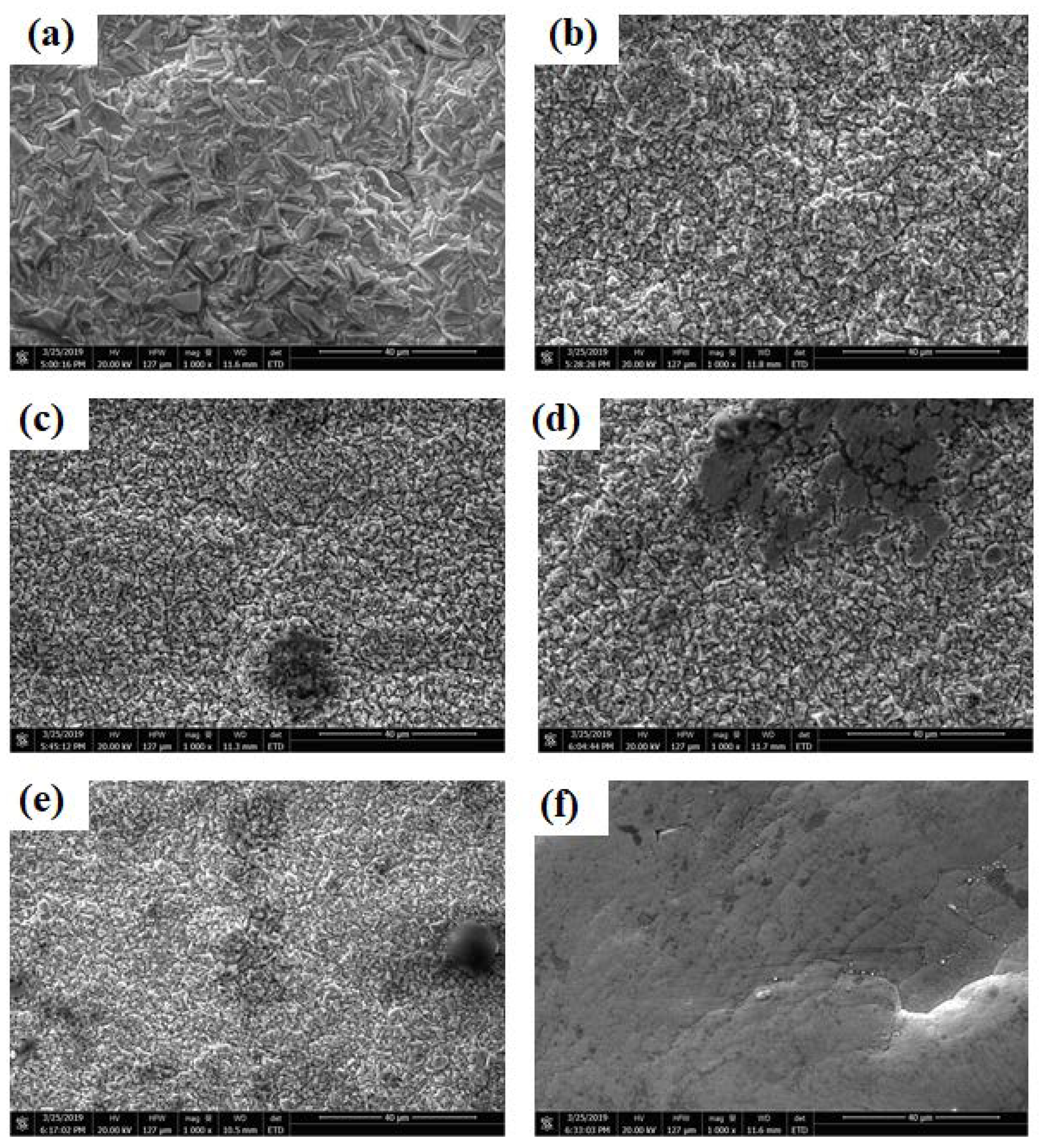
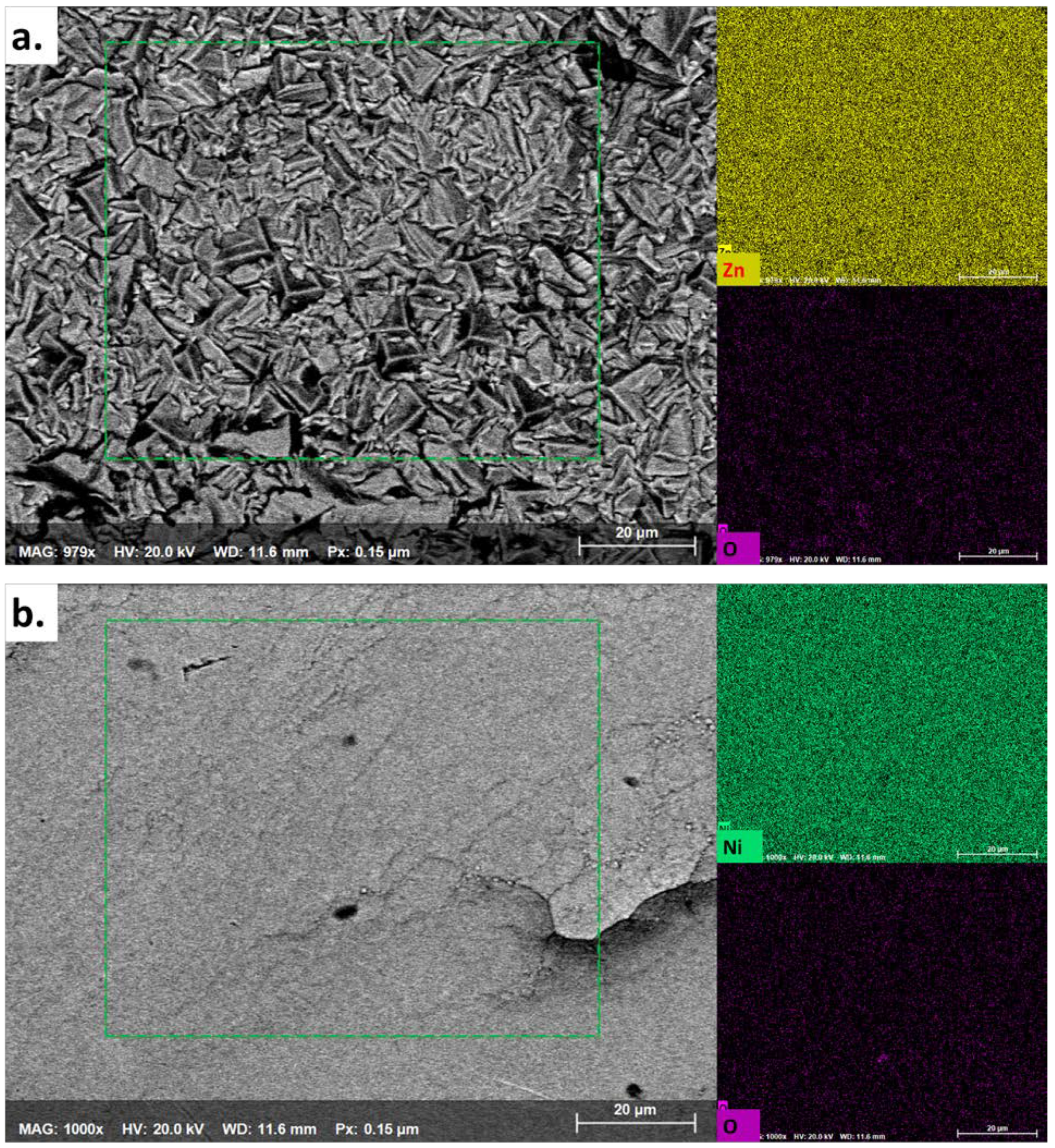
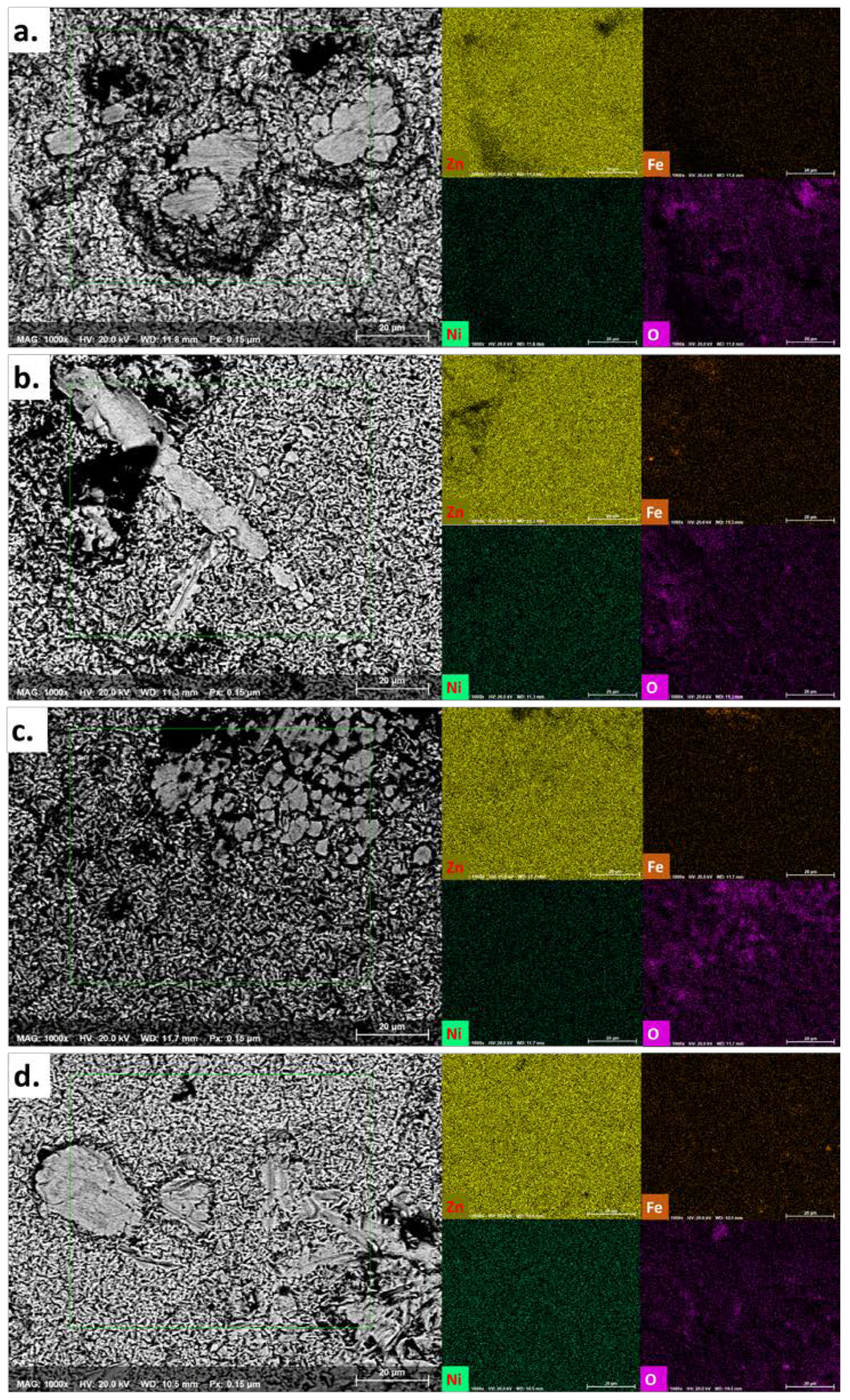




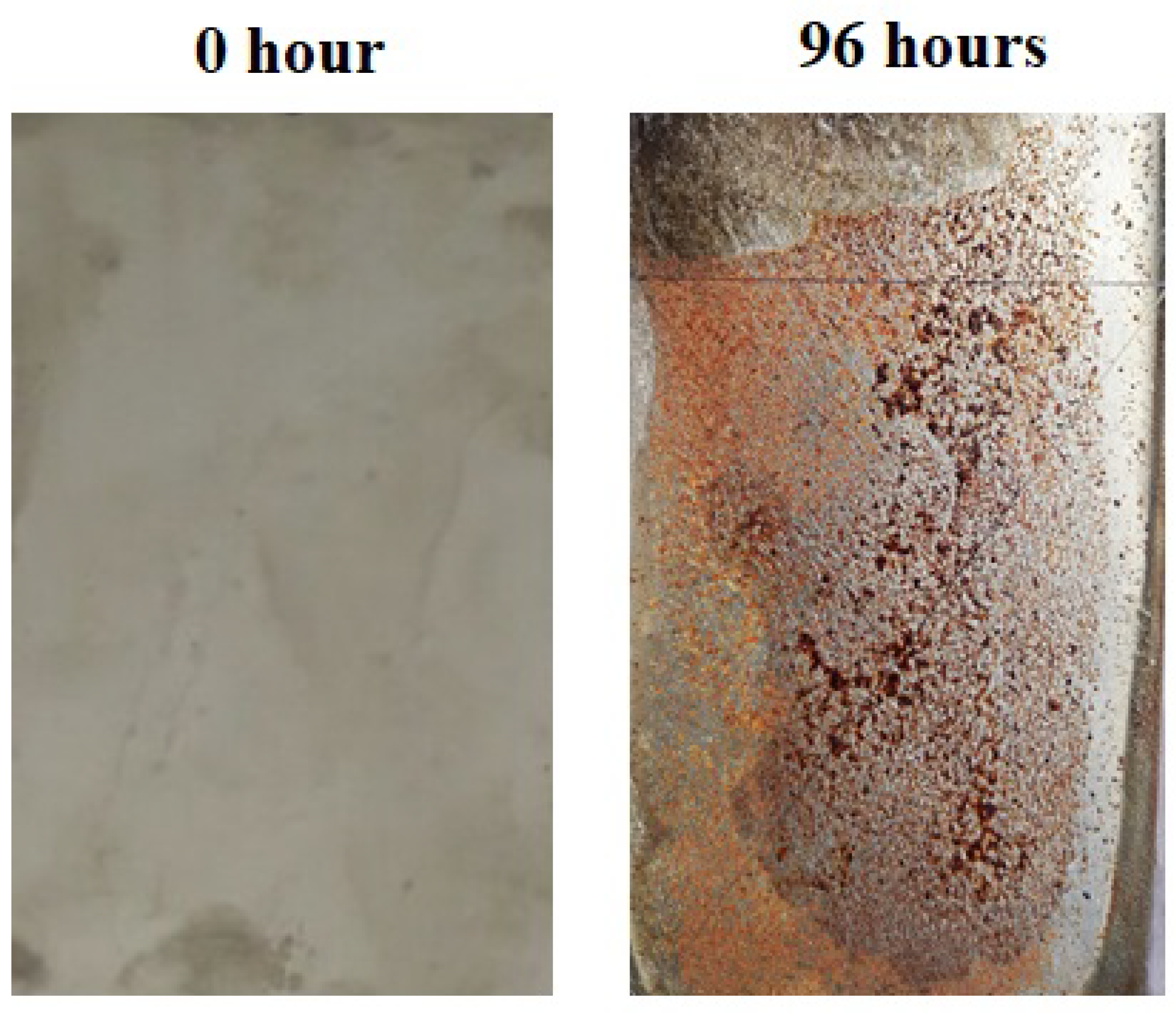
| Concentration | Zn Bath | Ni Bath | Zn-Ni-10 Bath | Zn-Ni-15 Bath | Zn-Ni-20 Bath | Zn-Ni-25 Bath |
|---|---|---|---|---|---|---|
| ZnSO4 (g·L−1) | 150 | - | 150 | 150 | 150 | 150 |
| NiSO4 (g·L−1) | - | 15 | 10 | 15 | 20 | 25 |
| * Ni Contents Wt% | βa (mV-decade−1) | βc (mV-decade−1) | icorr (μA-cm−2) | Ecorr (mV) | Corrosion Rate (mpy) | |
|---|---|---|---|---|---|---|
| Bare Steel | 73.7 | 44.2 | 5.56 | −969 | 2.541 | |
| Zn | - | 38.3 | 297.2 | 57.10 | −1240 | 26.12 |
| Ni | - | 284.2 | 171.9 | 3.27 | −734 | 1.50 |
| Zn-Ni-10 | 2.9 ± 0.9 | 130.8 | 236.2 | 26.50 | −1270 | 12.12 |
| Zn-Ni-15 | 3.4 ± 1.0 | 117.9 | 129.9 | 25.12 | −1290 | 11.44 |
| Zn-Ni-20 | 4.1 ± 0.7 | 122.9 | 86.8 | 19.20 | −1280 | 8.80 |
| Zn-Ni-25 | 5.3 ± 1.0 | 87.6 | 99.7 | 15.90 | −1300 | 7.25 |
Publisher’s Note: MDPI stays neutral with regard to jurisdictional claims in published maps and institutional affiliations. |
© 2022 by the authors. Licensee MDPI, Basel, Switzerland. This article is an open access article distributed under the terms and conditions of the Creative Commons Attribution (CC BY) license (https://creativecommons.org/licenses/by/4.0/).
Share and Cite
Farooq, A.; Ahmad, S.; Hamad, K.; Deen, K.M. Effect of Ni Concentration on the Surface Morphology and Corrosion Behavior of Zn-Ni Alloy Coatings. Metals 2022, 12, 96. https://doi.org/10.3390/met12010096
Farooq A, Ahmad S, Hamad K, Deen KM. Effect of Ni Concentration on the Surface Morphology and Corrosion Behavior of Zn-Ni Alloy Coatings. Metals. 2022; 12(1):96. https://doi.org/10.3390/met12010096
Chicago/Turabian StyleFarooq, Ameeq, Sohaib Ahmad, Kotiba Hamad, and Kashif Mairaj Deen. 2022. "Effect of Ni Concentration on the Surface Morphology and Corrosion Behavior of Zn-Ni Alloy Coatings" Metals 12, no. 1: 96. https://doi.org/10.3390/met12010096
APA StyleFarooq, A., Ahmad, S., Hamad, K., & Deen, K. M. (2022). Effect of Ni Concentration on the Surface Morphology and Corrosion Behavior of Zn-Ni Alloy Coatings. Metals, 12(1), 96. https://doi.org/10.3390/met12010096








